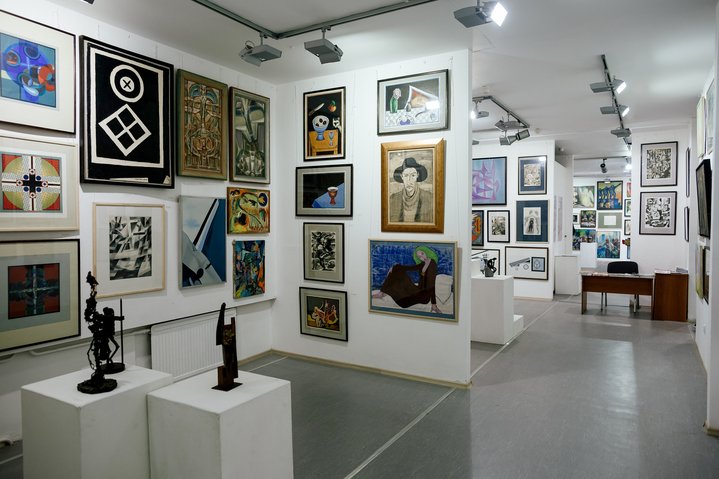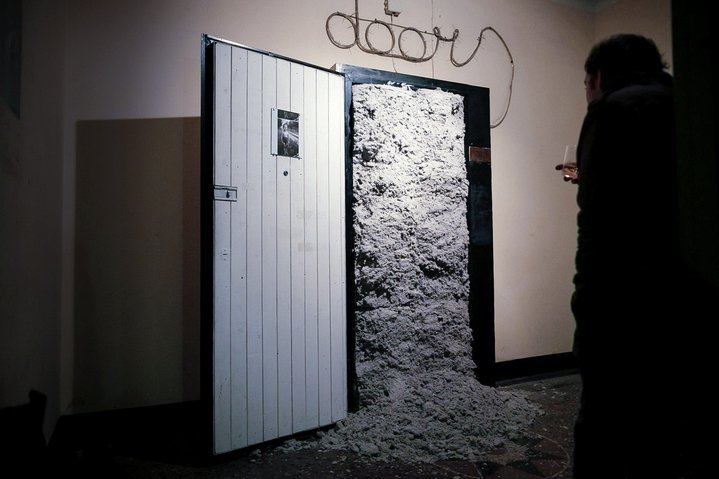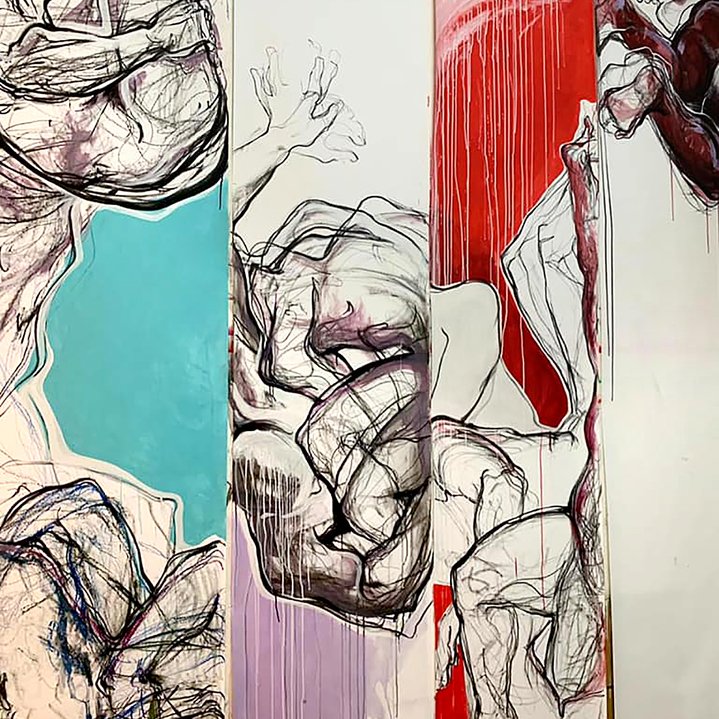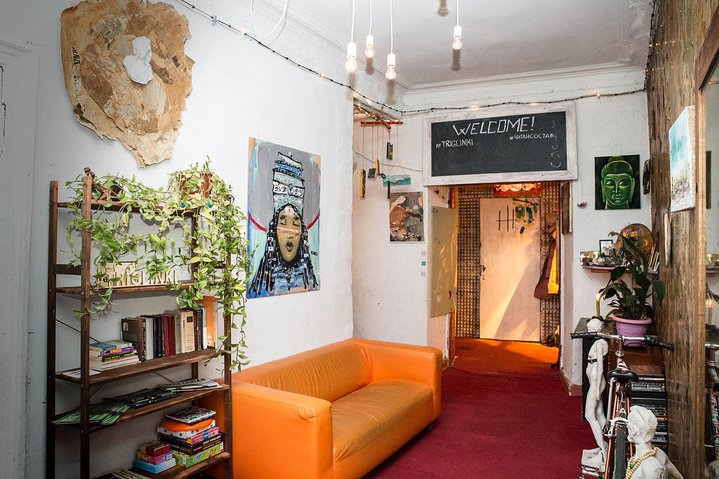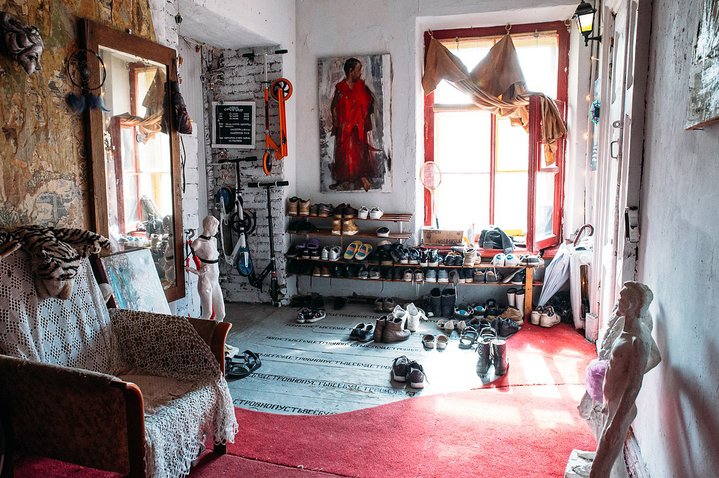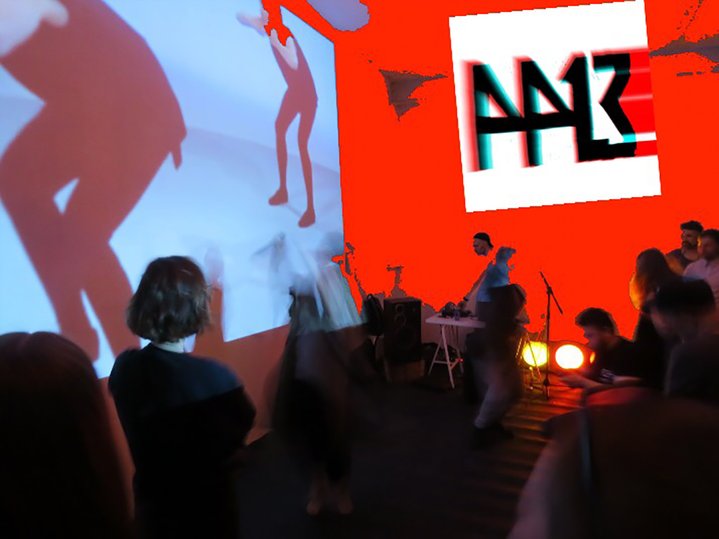Utyugon, the musical instrument designed by Sergei Kuryohin, on view at the “Pushkinskaya 10”
St.Petersburg self-organized art spaces
There’s more to contemporary art in St.Petersburg than what museums and galleries can offer. Self-organized art spaces where young and dynamic artistic communities live and work together are abound in the city: some turn out to be short-lived while others last for decades.
It’s an enduring cliché that, while Moscow is the official capital of Russia, St. Petersburg is its “cultural capital” and de facto guardian of the nation’s non-commercial soul. A number of features makes St. Petersburg uniquely conducive to creative life. Living costs are lower, which make the city friendly for students and up-and-coming artists. There already is a high concentration of creative actors within the city centre, an area which is significantly less commercial than downtown Moscow. There is also the physical and spiritual legacy of the city: the architecture, museums and thoroughfares themselves are creative expressions that have stood the test of time and remain inspiring to both emerging and established artists. These and other factors have combined to give rise to a number of shared living spaces where artists not only gather, but also live and create. They range from the well-established to the underground, but what unites them is the desire to combine art and life.
The Vanguard
Arguably the most successful of the city’s artistic communes, ‘Pushkinskaya 10’ (which refers to the space’s physical location on Pushkinskaya street) emerged in the early 1990s, the fruit of late Soviet non-conformist art movements which had banded together to create the ‘Cooperative of Experimental Fine Arts’. In the wake of the Soviet Union’s collapse, prominent local artists used the space to live and work with a series of new galleries and workshops, as well as staging exhibitions, some of which were shown in Europe and the United States. A number of iconic rock musicians from the late Soviet period also frequented the centre, including Aquarium's Boris Grebenshchikov (b. 1953) and Nautilus Pompilius' Vyacheslav Butusov (b. 1961). Today, the commune has developed into an entire complex, housing 15 galleries, 38 studios, a concert hall, two nightclubs, as well as a children’s theatre and the Museum of Non-Сonformist Art. Some artists turned their studios into memorable museums, such as that of photographer and sculptor Andrey Chezhin’s (b. 1960) Pushpin (sic!) Museum.
While ‘Pushkinskaya 10’ opened its doors in the heart of the city and continues to offer events for an ever-growing audience, the artist commune on Nepokorennie Avenue, in the city’s northern reaches, remains set apart from the city centre’s bustle. It was founded by the artists Anastasia Shavlokhova (b. 1984), Ivan Plyushch (b. 1981) and Ilya Gaponov (b. 1981), all graduates of the Stiеglitz St. Petersburg Academy of Art and Design, where they were trained in classical painting. Located in the loft of a former rocket factory, the workshops at Nepokorennie cater to a new generation of artists. Assembled at the beginning of the last decade, Nepokorennie’s founding artists renovated the abandoned space, turning it into a series of 10 studios and, eventually, a gallery. At its launch, many of the group’s members ranged from their mid-20s to early 30s, injecting a fresh blood into the city’s underground commune scene.
The New Underground
Over the past five years, a number of new shared living spaces and communes have emerged in the city, many in the historical Kolomna neighbourhood. These often cater to particular projects in St. Petersburg’s diverse alternative culture ecosystem. A number of them offer more than conventional gallery space, and they often seek to foster interdisciplinary events that bring together artists, activists and academics.
The ‘Triglinki’ art space is located on the edge of Kolomna, right beside the Mariinsky Theatre. Founded in 2015 by musician, artist and collagist Ruslan Larochkin (b. 1989), its priority is to maintain space for both permanent and visiting artists, many of whom have left their art on the walls as they moved on. Triglinki combines art with activism. All its members stick to a vegetarian lifestyle, while they live in the space and host events on responsible consumption, animal rights and more. They also bring in artists from different disciplines for performances. These range from poets to singer-songwriters to aspiring DJs and rappers.
The founders of the ‘4413’ collective, curator Maria Dmitrieva (b. 1987) and curator/artist Vanya Shatravin-Dostov (b. 1995), also made their home in Kolomna. The self-proclaimed “laboratory of alternative discourse and intersectional kinship” only opened in May 2019, yet it has already made an impressive mark on the underground art and culture scene in St. Petersburg.
The artists at ‘4413’ renovated a dilapidated building with an aesthetic that provides a jarring contrast with the glittering New Holland island complex just across the street. Funded by oligarch Roman Abramovich (owner of Chelsea Football Club) the restoration of New Holland was planned to attract and entertain locals as well as tourists. That hipster attraction is regarded by some members of the cultural underground as an intrusion. Many of the neighbourhood’s art communes, including ‘4413’, promote an alternative vision based on inclusivity, grassroots consensus and DIY solutions to the city’s cultural issues. Their impressive list of events staged by the group over the past half year has proved that they are intent on hitting the mark. From hosting exhibitions, round tables, theatre productions and the city’s first Queer Biennale, artists at ‘4413’ are determined to create art as well as provide space for St. Petersburg’s diverse social and artistic scene.
Some of these spaces operate independently, while others look to link up with the city’s many different spaces, events and communes. What’s for sure, however, is that through the generations St. Petersburg has produced waves of dynamic artists looking to upend our expectations of what it means to live, produce and present art in the 21st century.






